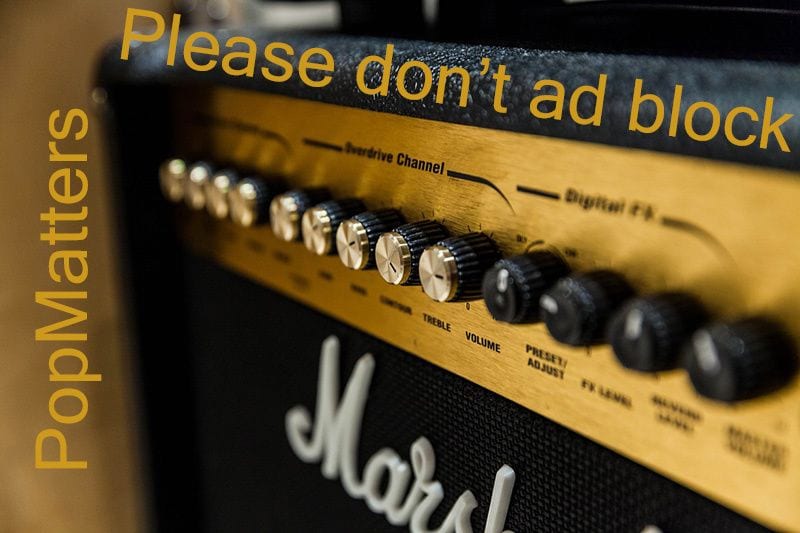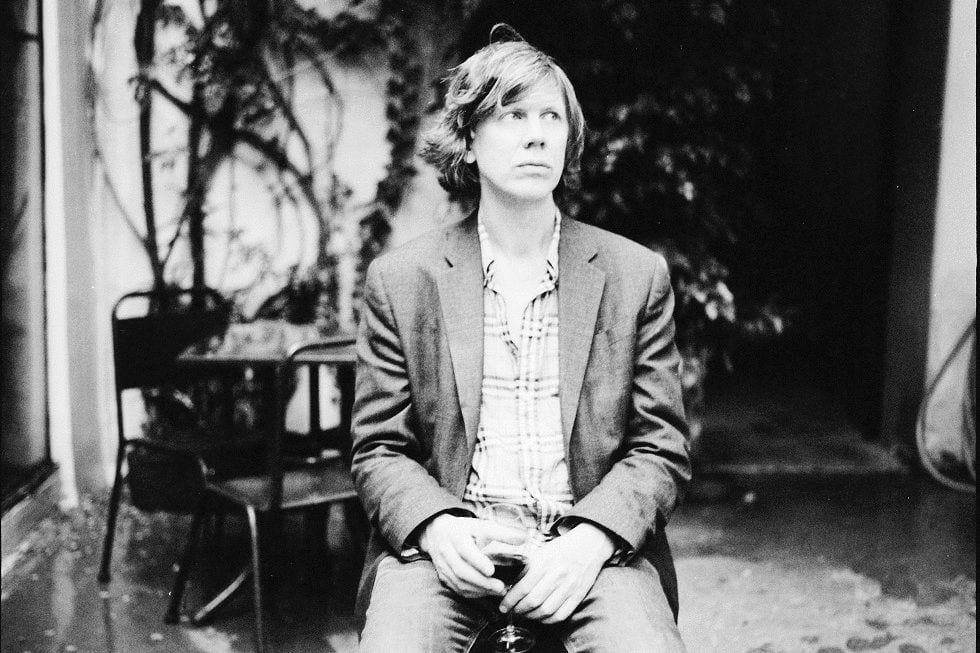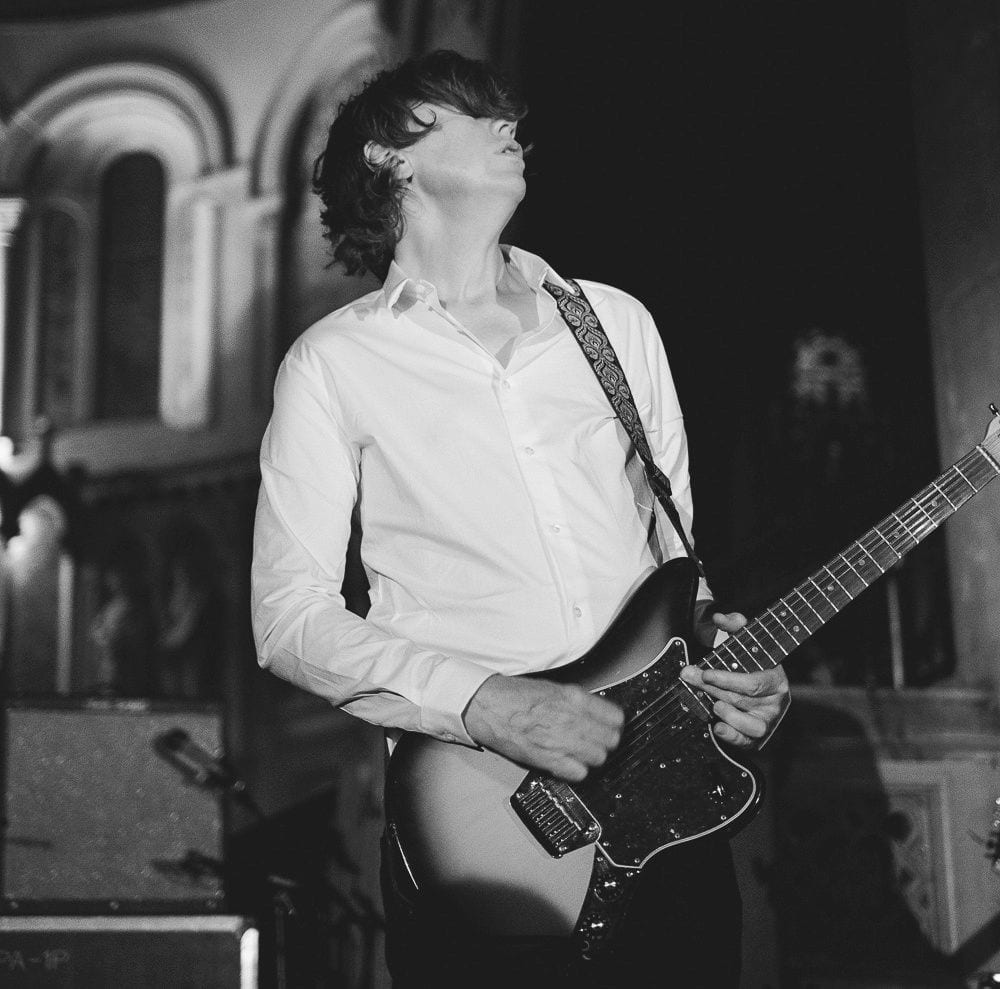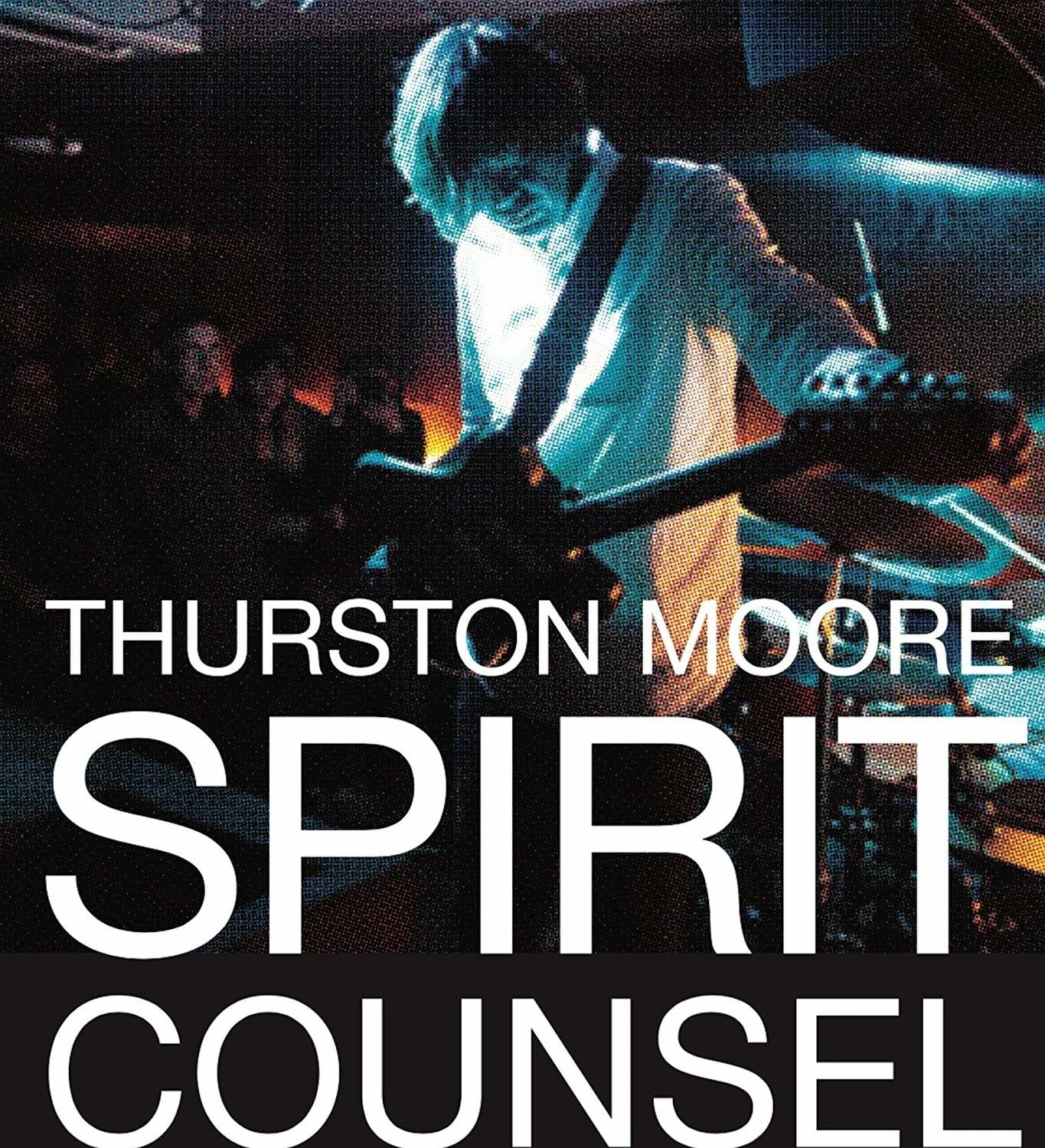
A couple of years ago, Thurston Moore noticed that nearly every record store he stopped into — and that was a lot of record stores — was playing Alice Coltrane.
“There have been a lot of recordings that have been released to the public in the last few years of her devotional music, when she spent time in the Ashram in California that she, I think was a director of,” Moore starts explaining. “The music was really astounding, and it came from so many places that I’m interested in such as avant-garde jazz, the history of African American culture, a history of spirit music that you’ll find in ashrams. I’d hear it in music stores all the time. It’s like, ‘Oh, you’re playing that record.'”
Moore heard an uplifting quality in Coltrane’s music that aligned with what he had been trying to do in Sonic Youth. “No matter how experimental, how jarring, how even nihilist it could be, the music still had a kind of uplifting vibe to it. I felt like that was essential to songwriting always,” he said. So, he began digging into the story of Alice Coltrane and other female artists whose careers had developed in the shadows of more famous male partners — the visual artist Moki Cherry, married to Don Cherry, and the poet Jayne Cortez, the wife of Ornette Coleman.
“I was thinking about these three people who really didn’t necessitate any real public profile to do their work. Unlike their husbands, who were really sort of part of this industry of needing that profile,” he said. These three women became a sort of “spirit counsel” who inspired the 65-minute track of the first disc, “Alice Moki Jane”, and also the project as a whole, which collected three extended instrumental compositions, all very different from Sonic Youth or Moore’s previous solo albums.
Marshall Amp by tookapic (Pixabay License / Pixabay)
Going Long and Without Words
Spirit Counsel is not for the attention-span challenged, and none of its tracks will fit very easily into your workout mix. It requires most of an afternoon to get through in one go, and though all three pieces present the electric guitar in a varied, engrossing light, there are no words to build an imaginary narrative around. “I just felt like I wanted to do long-form compositions,” says Moore. “I wanted to focus on the music without having any verbiage.”
Moore has been traveling in Europe a lot lately and noticing that English-language pop predominates, even in non-English speaking countries. “It’s accepted as the sovereign kind of music, coming out of the English-speaking world. It’s always kind of weirded me out a little bit,” he says. “I will notice, say, in the middle of Italy, a taxi driver who doesn’t speak English, singing along to an English-language song. It’s very strange.”
Moore tells a story about attending an Italian wedding, where the DJ played a set of American hits, then another of Italian pop. “The whole place lit up, and they were singing along vociferously. Like, okay, now we have our music,” he recalls. “I felt well, that’s a good relationship, but I felt like I wanted to make music that didn’t have that barrier of language there. And just have it be just music of guitars and instrumentation.”
So, Moore set to work writing the first piece, “Alice Moki Jane” as a solo for 12-string electric guitar. He played it live a few times, then invited frequent collaborators Deb Googe (from My Bloody Valentine), James Sedwards, and Steve Shelley to have a look. “I said, well, I have a new song. And it’s 60 minutes long. And would you like to learn it? And after a beat of silence, they were like, sure,” he recalls.
Moore had written his composition down, using guitar staves to document the fingering and the chords. That was a new experience for him. Everyone in Sonic Youth had learned the music by ear and memorized it. “When we did Daydream Nation as a whole, ten years after the fact, we had to go back to the master tapes, parse them down to each of our separate tracks, to figure out what the hell we were doing. There was no documentation otherwise,” he remembers.
Googe, Sedwards, and Shelley had been Moore’s band for a while, but he added John Leidecker, aka “Wobbly” from Negativland, later. The two had met at a John Cage symposium and hit it off, then Moore asked Leidecker to open for him. “There was one evening where we were at a festival, and he didn’t have a gig, and we did…we said why don’t you play with us? You’ve heard this piece 20 times. And what he did was so astounding, I said, ‘Where have you been all my life?’ So, he joined the group.”
The Glory of the Song
All three pieces are abstract, stirring, evolving continuously over their entire duration. Though the first pays tribute to the three women in its title and the second, “8 Spring Street” to Glenn Branca, Moore avoided overt musical references for the most part. “I didn’t want ‘Alice Moki Jayne’, for instance, to be in direct musical reference to Alice’s work,” says Moore. “But, that said, when I was writing the piece, there was this little motif of Alice Coltrane’s, a bit of an A to B to A to B thing that I had heard in one of her songs that was in the composition.”
He emphasizes that all three pieces were composed, not improvised, though ideas can come through free form exploration. “The way I compose is, I’ll sit down with the guitar and I’ll just start playing and finding things and then thinking about how one thing can go to another and how things can sort of return and create this structure,” Moore explains. “It’s all about structure. Even in Sonic Youth, the idea of being an ‘experimental’ band, wasn’t so much about the way we used alternative tunings or different instrumentation on the guitars. It was primarily about structure and how you can structure a piece of music and still be able to refer to it as a song in the context of pop music.”
Moore refers to all three of these compositions as songs, a concept that’s important to him, regardless of how far out there he goes. “I remember when I was getting really involved in working with free improvisers and doing noise music in the 1980s into the 1990s, and I remember driving around and touring with Pavement in Europe and being in a rental car with Steve Malkmus, and playing some kind of noise improv thing that I was doing. And he was like, ‘That’s really cool, but don’t forget the glory of the song.’ And that stuck with me when he said that, ‘Don’t forget the glory of the song.'”
Photo: Vera Marmelo / Courtesy of Ground Control Touring
Remembering Glenn Branca
“8 Spring Street” is an homage to Moore’s contemporary and sometime collaborator Glenn Branca, who passed away in 2018. The two of them did about as much as anyone to redefine the way guitars could sound in contemporary music, Branca working primarily in avant-garde classical styles (after a dalliance with no wave) and Moore in experimental rock.
Moore saw Branca play in Theoretical Girls early in the No Wave era. His pre-Sonic Youth band, the Coachman, shared a bill at Jenny Holzer’s loft space with the Static. “As I was getting it together to do Sonic Youth and meeting Kim and meeting Lee, there was a certain sound I really was wanting to exact. I was sort of hearing in the no wave music, be it Mars or DNA, and in those bands Glenn was in,” he said. The sound he heard in his head was a roar of guitar noise, akin to the punk rock of the Sex Pistols or the Ramones or the Slits, but different.
Moore went to see Branca perform “Instrumental for Six Guitars”, and experienced a revelation. “It was a really great rush of music. And I would soon realize that the guitars were tuned out of tradition. One guitar is all high E strings, the same gauge, ten gauge on one guitar, and the next one is D or G or A. So, the six guitars were one big guitar. Each one was a string, but tuned to six strings,” he remembers. “And that kind of was how I got really into what Glenn was doing.”
Shortly afterward, Branca placed an ad for “guitarists willing to play weird tunings,” and Moore responded. “I went over to his place, which was 8 Spring Street and sat in this room, and he asked me a couple of questions. You know, ‘Do you know how to play double strumming?’ I was like of course, who doesn’t? I can play triple, quadruple strumming. And he was like, ‘Can you play harmonics?’ And at the time I said, I primarily played harmonics. Not notes and chords. And he just looked at me like I was nuts.”
Branca didn’t hire Moore right off the bat, but within a few weeks, he called to offer him a spot. Moore toured Europe and England for the first time with Branca, then returned to New York to start up Sonic Youth. Branca had just started a record label called Neutral. Sonic Youth recorded its first CD on it.
“We’d been together less than six months when we went into this wonderful studio in Midtown Manhattan. It was where they recorded the Thelonious Monk Orchestra. A huge studio. 24-track. For our very first recording, we did that,” says Moore. “The second one, we did in a basement in Wharton Tiers building with broken machines.”
Moore and Branca kept in touch, even as Moore waded deeper into post-punk and rock, and Branca directed his energies towards the art world. “I don’t think he had much time for the post-punk world. He wanted his stuff to have a bit more of this kind of air of serious music. I wanted to be where Minor Threat was,” says Moore.
Photo: Vera Marmelo / Courtesy of Ground Control Touring
12-String Squared
The third and final disc of the Spirit Counsel set is called “Galaxies”. Moore composed it for a performance at the Barbican in London in 2018. It employs twelve 12-string electric guitars in a glorious clangor that sounds, at times, like a million church bells ringing at once.
It was not the easiest thing to organize, Moore says. “Somehow we had to find all these guitars and guitarists. Not all guitarists own 12-string guitars.” Working the phones, Moore called guitar makers to find the instruments, the amps, the musicians, not all of whom were completely versed in the 12-string. “There were some people who had some kind of technique of playing, and there were others who had never touched a 12-string guitar,” he says. “When I got that in place, I locked the door and wrote these two pieces, one acoustic and one electric, for this concert. And played it, premiered it, and it was a really wonderful night.”
The evening’s music was recorded on ambient microphones, and Moore felt that the acoustic piece, while exciting in the room, hadn’t come across very well on tape. “But the electric guitar piece was all about focusing and investigating the noise properties of an amplified electric 12-string guitar, times 12 and creating this more sort of industrial noise piece of music,” he says. “That one sounded more releasable to me. And I knew that doing this CD set that I had these two CDs of fairly approachable music. To have a third CD with this more brutalist kind of music, I wasn’t quite sure if I wanted it in there or not, but I didn’t want to leave it behind. I thought there was a relationship between the three pieces, because they were written at the same time, curated.”
A Means to An End
All three pieces — and indeed, almost everything Moore has ever done with Sonic Youth or otherwise — put the guitar in the foreground. He has become nearly synonymous with guitar. And yet, he admits, “I’ve never really considered myself so much Mr. Guitar. To me, playing guitar was a means to an end. I needed to play something.”
As a youngster, he borrowed his older brother’s guitar and taught himself to play. He says he’s always liked non-traditional guitar players like Lydia Lunch or Pat Place (of the Contortions) or Patti Smith better than technical virtuosos.
“One of the greatest lead guitar players I ever saw was Lita Ford, who was in the Runaways, and I remember seeing them in the 1970s and thinking I wish I could play like that. But I don’t really want to go that route,” he says. “Glenn [Branca] wasn’t a rock and roll guitarist, but he was playing incredible rock music with guitar by really refocusing on what the guitar can do to his own ear and to his own interest. That to me is where I went with guitar.”
“When I go on tour and James Sedwards who plays guitar with me, he loves the guitar. He’s like J Mascis. He loves everything about the guitar and loves to go to guitar stores. Most guitar players love to go to guitar stores and ogle at the guitars. Fetish the guitars,” says Moore. “I really don’t care about going to guitar stores. I go to second-hand bookstores and second-hand record stores before I’d ever go to a guitar store.”
- An Artist in His Own Right: Nick Soulsby on Thurston Moore ...
- Thurston Moore: Demolished Thoughts - PopMatters
- Thurston Moore: The Best Day - PopMatters
- In My Own Space: A Conversation with Lee Ranaldo - PopMatters
- Sonic Youth: Rather Ripped - PopMatters
- Sonic Youth: Murray Street - PopMatters
- Sonic Youth: The Eternal - PopMatters
- Sonic Youth: SYR9: Simon Werner a Disparu - PopMatters
- Thurston Moore and Lee Ranaldo Share Lockdown, Shelter in Place, Protest Gems - PopMatters
- Thurston Moore - Spirit Counsel - CDx3 – Rough Trade
- Thurston Moore
- Thurston Moore - Home | Facebook
- Thurston Moore (@thurstonmoore58) • Instagram photos and videos
- Thurston Moore (@nowjazznow) | Twitter
- www.sonicyouth.com : official website of sonic youth
- Sonic Youth (@thesonicyouth) | Twitter
- Sonic Youth - Home | Facebook
- Sonic Youth | Discography & Songs | Discogs





